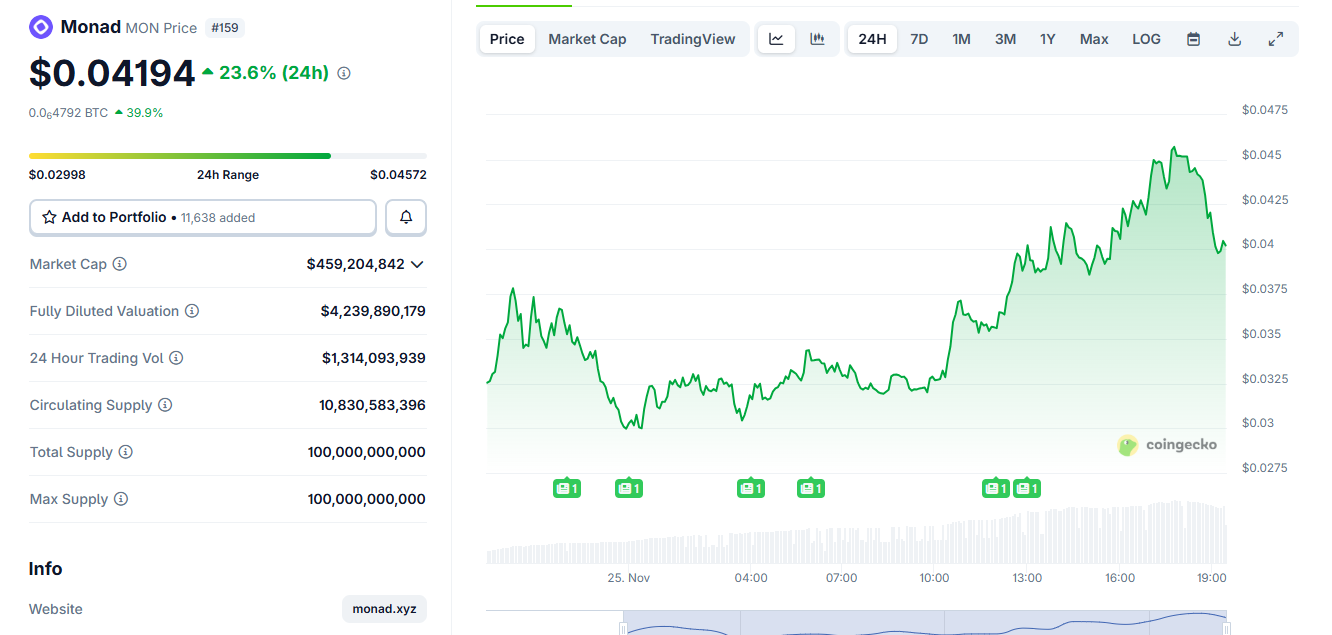Monad Is Still Rallying, But How Long Will It Last?
0
0

Monad’s MON token continues to rally after its long-anticipated mainnet launch, defying the steep post-airdrop declines that dominated 2025. The token has climbed more than 70% above its Coinbase sale price while the broader crypto market trades under heavy pressure.
Data from on-chain activity, exchange flows, and token distribution offer a clear explanation for the outperformance — and reveal how long the rally may realistically last.
Strong Day-One Performance Sets the Tone
Monad launched its public mainnet and MON token on November 24 with roughly 10–11% of its 100 billion supply unlocked.
The airdrop and public sale provided liquidity, while more than 50.6% of the supply (team, investors, treasury) remained locked through 2029.
 Large Monad Holders Are Still Not Selling Any MON Token. Source: Nansen
Large Monad Holders Are Still Not Selling Any MON Token. Source: Nansen
The launch attracted immediate attention. MON dipped about 15% in early trading, hitting $0.02 as airdrop sellers exited.
Buyers quickly absorbed the flow. Within 24 hours, MON traded near $0.03–0.035, and now sits around $0.04, more than 50–70% above its $0.025 public sale price.
This strength stands out in a market where Bitcoin has dropped below $90,000 and total crypto market capitalization has fallen by more than a trillion dollars since October.
 Monad Price Chart. Source: CoinGecko
Monad Price Chart. Source: CoinGecko
Airdrop and Token Sale Created a Stable Holder Base
Monad distributed roughly 4.73 billion MON in airdrops to 289,000 eligible accounts, with 3.33 billion ultimately claimed. The design targeted DeFi power-users, NFT traders, testnet contributors, and DAO participants rather than quest farmers.
The Coinbase token sale, which raised $269 million from about 85,820 participants, added a second cohort of committed holders. These buyers anchored around the $0.025 sale price and proved less eager to dump at launch.
Because insiders remain locked, early sellers were mostly airdrop recipients. This dynamic helped prevent the heavy cascades that crushed many 2025 airdrops.
Heavy Exchange Coverage Shielded MON From Volatility
MON was listed across major exchanges on day one, including Coinbase, Upbit, Bithumb, Kraken, Bybit, Bitget, Crypto.com, and MEXC. Derivatives opened on multiple venues, giving traders hedging options.
Deep order books absorbed airdrop selling. Market makers tightened spreads, and cross-venue liquidity reduced fragmentation. Traders could short, long, or hedge without flooding spot markets.
This broad coverage sharply contrasts with earlier L1 launches that relied on thin liquidity pools and fragmented markets, often triggering immediate 50–80% crashes.
On-Chain Activity Surprised the Market
Monad’s first 24 hours delivered rare on-chain traction for a new L1. Nansen recorded:
- 3.7 million transactions
- 153,000 active addresses
- 18,000 contract deployments
These figures exceed what many blockchains achieve in their first year. They show early real usage from bots, arbitrageurs, developers, and liquidity programs.
TVL reached ~$90 million, with Uniswap, Gearbox, Curve, and native dApps launching within hours. DEX volume crossed $70 million, driven by concentrated liquidity pools and farming incentives.
This early activity reinforced the perception that Monad launched as a functioning ecosystem, not as a speculative token awaiting future development.
Monad’s Rare Relative-Strength Play in a Weak Market
MON’s rally stands out because the rest of the market remains fragile. Bitcoin’s slide under $90,000 triggered retail outflows and pushed sentiment indicators into extreme fear.
Traders rotated into MON due to its relative strength. New tokens with credible metrics often attract momentum capital when major assets struggle.
This reflexive flow — strength attracting more capital — added fuel to the rally.
Arthur Hayes Goes All-In
Arthur Hayes weighed in with a sarcastic comment that captured the market mood.
He highlighted MON’s low float and high FDV (fully diluted valuation). With only around 10% of supply circulating and FDV near $3–4 billion, MON fits the low-float pattern that dominates early-stage price action.
Yet Hayes admitted he bought anyway. His remark reflects how traders treat early L1 tokens: fundamentally risky, but attractive for short-term speculation.
How Long Can the Monad Rally Last?
The current data and patterns point to three time horizons that shape MON’s outlook.
Short Term: Rally Can Sustain
Monad has absorbed its largest early unlocks. Liquidity remains deep, and on-chain usage is rising. Incentive programs are launching, and trading flows remain strong.
Under these conditions, MON can maintain upward momentum for days or weeks.
Medium Term: Unlock Pressure Builds
Over the next several months, the circulating supply will rise as vesting tranches unlock. Even disciplined insider distribution adds structural sell pressure.
Activity may normalize after early incentives fade. If TVL flattens or starts slipping, the narrative could shift.
Longer Term: Fundamental Execution Matters
MON’s FDV places high expectations on the chain. Sustained growth in TVL, real applications, and developer traction will determine long-run resilience.
Without continued expansion, valuation compression becomes likely as supply expands.
Monad Token Outlook
Monad’s rally stems from a rare combination of strong distribution design, deep exchange liquidity, high early usage, and standout performance during a weak market.
This alignment makes MON one of the few 2025 airdrop tokens to defy the typical post-launch collapse.
The rally can continue in the short term as long as on-chain demand holds and liquidity remains supportive. However, the token’s high FDV and long vesting schedule introduce clear medium-term risks.
For now, MON remains a high-momentum asset driven by early fundamentals and speculative flows.
However, the durability of that momentum will depend on whether Monad converts its powerful first 48 hours into sustained ecosystem growth.
0
0
 Manage all your crypto, NFT and DeFi from one place
Manage all your crypto, NFT and DeFi from one placeSecurely connect the portfolio you’re using to start.







